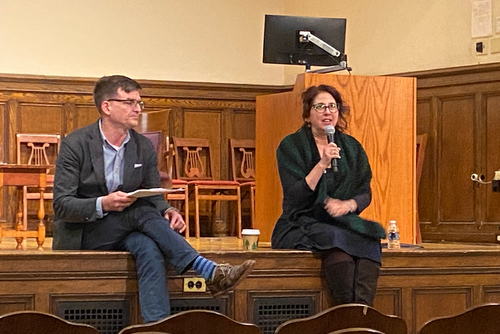
On March 2nd, the Baltic Studies Program and the European Studies Council of the Yale MacMillan Center presented a screening of “Mariupolis 2” (2022). Thanks to the hard work of Baltic Studies Coordinator Bradley Woodworth, on Thursday night members of the Yale community gathered at the 53 Wall Street Auditorium to watch a documentary film depicting everyday life during war in Ukraine. The screening was followed by a discussion with Marci Shore, Associate Professor of European Intellectual History at Yale. Her latest book titled The Ukrainian Night: An Intimate History of Revolution was published by Yale University Press in 2018.
Mantas Kvedaravičius (1976-2022) was a Lithuanian-born filmmaker, killed by Putin’s army in Mariupol, Ukraine in the spring of 2022. Kvedaravičius received his PhD in Social Anthropology from Cambridge University in 2014. For his dissertation titled “Knots of Absence: Death, Dreams, and Disappearances at the Limits of Law in the Counter-Terrorism Zone of Chechnya,” Mantas worked with Chechen mothers searching for their disappeared sons in the city of Grozny in the aftermath of the Second Chechen War. His debut film “Barzakh” (2011), based on the anthropologist’s fieldwork, made waves at international film festivals, wining multiple awards. His second film “Mariupolis” (2016) depicted everyday life in the wartime Ukrainian city. In March 2022, Mantas Kvedaravičius interrupted work on his fiction film “G.O.M.A.” in Uganda and returned to Mariupol to film a sequel. Soon after, Mantas was detained and subsequently killed by Putin’s forces. He is survived by his partner Hanna Bilobrova and two children.
“Mariupolis 2” contains the footage Mantas Kvedaravičius was able to capture just before his death. “My films are not about war, but about life next to war, life lived in spite of war,” Mantas said in one of his interviews. Tragically, the filmmaker who intended to document life during wartime fell victim of the war himself. The film lasts for one hour and fifty-two minutes. The filmmaker follows Russian-speaking members of the Christian Baptist Evangelical Church over the course of a week at the end of March 2022 as they survive the siege of Mariupol. Camera rarely leaves a brick-built church, one of a few buildings still standing at the landscape of ruins, where elderly people, mothers with children, and a few men found a shelter. “Все в руинах (Everything is in ruins),” – a man announces in Russian as the film begins. We see the destroyed city of Mariupol from up close: empty streets, shattered windows, damaged houses, broken trees, and rubbish everywhere. We follow two men as they pull a heavy generator taken from someone’s wrecked house down the street. To do that, they had to remove two dead bodies blocking the doorway, most likely killed in a blast. Numerous long takes, filmed at the church’s rooftop, show a cityscape smoking from explosions throughout the film. The city, or what is left of it, seen from multiple perspectives, becomes the film’s protagonist. In one of the final scenes, Mantras and an elderly man walk through debris to see the man’s destroyed property. Standing in the ruins, the man gives us a detailed explanation of what has happened here. “Нет дома моего (I don’t have a house),” he says. On March 4th at 22:30PM, a bomb, dropped from a plane, destroyed seven houses. The man shows us a crater of 20 m (65.6 ft) in diameter and 10 m (32.8 ft) deep which Mantas helps him estimate – a place where one of the houses stood. The man was going to repair his house before the bomb exploded. They used to have 300 pigeons and other birds. He approximates the number of survived pigeons still flying around – about twenty – and picks up two dead parakeets from the pile of rubbish. “Тридцать два года отработал и на старость остался нищим. Зачем я работал? Вот такая вот ситуация безвыходная (I worked for thirty-two years and ended up as a beggar in my old age. Why did I work? This is such a hopeless situation),” he tells Mantras.
The film’s soundscape intensifies the visuality of existence in the destroyed habitus. There is hardly silence. We constantly hear sounds of explosions and gunshots at various distances. We progressively learn the nuances of miscellaneous sonic experiences and their meaning, coming to recognize the engine noise of moving “техника” (tanks) or passing airplanes. The sounds of destruction interweave with chirping birds, barking dogs, crowing roosters, crackling wood in the fire pit where a soup being cooked. We listen to people’s voices talking about bombs, deadly explosions, and damages. We hear a prayer thanking God for protection, spring sunshine, and food cooked under bullets. The sounds of war and the sounds of life create a rich cacophony of the film’s sonic atmosphere. Which ones are to persist?
We hear a man saying that ordinary people need to ask for God’s forgiveness, embrace one another, and stop losing their lives for the wallets of those in power. Perhaps, this is how film’s protagonists, not involved in geopolitics, try to make sense of the incomprehensible cruelty and sudden destruction of their lives and livelihoods. Suddenly, the everyday routine of wartime survival at the church building is interrupted by a heartbreaking announcement about the shelter closing due to shortage of resources. After the shelling stops, everyone needs to leave. An elderly lady loudly declares that she has nowhere to go. “Куда идти? (Where to go?),” people keep asking.
The movie ends abruptly after one more long take of Mariupol with smoke rising on the horizon. We see the portrait of Mantas Kvedaravičius followed by the prolonged silence of ending credits.

